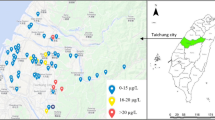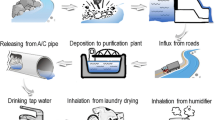Abstract
In Brazil, only 20.2% of the municipalities have sewage collection and treatment. The use of medical diagnostic by radiographic processing generates effluents which may contain contaminants such as silver (Ag) that causes irreversible damage to health. They can also contaminate soil, water, and food if there is no treatment before disposal. This study aimed to identify and quantify the Ag concentration in radiographic film-washing water and fixer generated from radiographic processing in 12 Brazilian health institutions, in order to offer subsidies to the environmental and public health managers about this issue. The Ag values found in the washing water films samples ranged from 0.1 to 1,785.97 mg L−1. In the fixer samples, the values ranged from 435.59 to 16,325.92 mg L−1. These data are far above the values required by Brazilian legislation whose limit is 0.1 mg L−1 for Ag in effluents released directly or indirectly into the environment. This research reveals that the disposal of Ag in this kind of effluent needs to be monitored and controlled by the Brazilian government in order to protect both the human and environment health from those contaminants.
Similar content being viewed by others
References
Ues K, Piaia L, Schweickardt M, Wastowski AD, Santos EP (2008). Uso de processos avançados de oxidação na degradação dos resíduos de revelador e fixador de raio-x. In: Encontro de Química da Região Sul, Blumenau, 16, 2008.
Hocevar CM, Rodriguez MTR (2002) Avaliação do impacto ambiental gerado por efluentes fotográficos, gráficos e radiológicos em Porto Alegre, RS. Brasil Eng Sanit Ambient 7(3–4):139–143
Makropoulos V, Alexopoulos EC (2006) Case report: hydroquinone and/or glutaraldehyde induced acute myeloid leukaemia? J Occup Med Toxicol 1:19
Teschke K, Chow Y, Brauer M, Chessor E, Hirtle B, Kennedy SM, Yeung MC, Ward HD (2002) Exposures and their determinants in radiographic film processing. AIHA J 63(1):11–21
Takigawa T, Endo Y (2006) Effects of glutaraldehyde exposure on human health. J Occup Health 48(2):75–87
Byrns GE, Palatianos KH, Shands LA, Fennelley KP, Mccammon CS, Boudreau AY, Breysse PN, Mitchell CS (2000) Chemical hazards in radiology. Appl Occup Environ Hyg 15(2):203–208
McGregor D (2007) Hydroquinone: an evaluation of the human risks from its carcinogenic and mutagenic properties. Crit Rev Toxicol 37(10):887–914
Washington State Department of Ecology (1997). Water Quality Program. Pollution prevention and treatment alternatives for silver-bearing effluents with special enphasis on photoprocessing. 1–78.
Ayrault S, Priadi CR, Evrard O, Lefévre I, Bonté P (2010) Silver and thallium historical trends in the Seine River basin. J Environ Monit 12:2177–2185
Philip Klapwijk (2009). World Silver Survey. The silver institute and gold fields mineral services Ltd. Washington, DC. Available via DIALOG http://www.gfms.co.uk/Market%20Commentary/GFMS_World_Silver_Survey_2009.pdf. Accessed 09 Dec 2010
Blaser SA, Scheringer M, MacLeod M, Hungerbuhler K (2008) Estimation of cumulative aquatic exposure and risk due to silver: contribution of nano-functionalized plastics and textiles. Sci Total Environ 390:396–409
Fernandes GS, Azevedo ACP, Carvalho ACP, Pinto MLC (2005) Análise e gerenciamento de efluentes de serviços de radiologia. Radiol Bras 38(5):355–358
Fernandes AL, Costa PHP, Andrade RT, Cavalcante Junior UH, Araújo VS, Leite JYP (2006) Análise do teor de prata e distribuição da geração dos efluentes radiográficos das zonas leste e sul de Natal-RN. In: Congresso de Pesquisa e Inovação da Rede Norte Nordeste de Educação Tecnológica, Natal, 1, 2006. CEFET-RN: 1–7
Bortoletto EC, Tavares CRG, Barros MASD, Carli CM (2005) Caracterização da geração e da qualidade do efluente líquido gerado no laboratório de raio-x da clínica odontológica do hospital universitário de Maringá (HUM). In: Congresso Brasileiro de Engenharia Química em Iniciação Científica, 6, 2005. UNICAMP-Campinas: 1–6
Brasil. Ministério do Meio Ambiente. Conselho Nacional do Meio Ambiente (CONAMA). Resolução n° 358, de 29 de abril de 2005. Dispõe sobre o tratamento e a disposição final dos resíduos dos serviços de saúde e dá outras providências. Diário Oficial da União, Brasília, DF, 04 maio 2005a.
Brasil. Ministério do Meio Ambiente. Conselho Nacional do Meio Ambiente (CONAMA). Resolução n° 357, de 17 de Março de 2005. Dispõe sobre a classificação dos corpos de água e diretrizes ambientais para o seu enquadramento, bem como estabelece as condições e padrões de lançamento de efluentes. Diário Oficial da União, Brasília, DF, 18 mar. 2005b.
Ndungu K (2010) Dissolved silver in the Baltic Sea. Envion Res. doi:10.1016/j.envres.2010.09.015
Grayson M (1983) Silver and silver alloys; silver and compounds. In: Grayson M (ed) Encyclopedia of chemical technology, 3rd edn. Wiley, New York, pp 1–32
Bortoletto EC, Igarashi-Mafra L, Sorbo ACAC, Galliani NA, Barros MASD, Tavares CRG (2007) Remoção da prata em efluentes radiográficos. Acta Sci Technol 29(1):37–41
Luoma SN et al (1995) Fate, bioavailability and toxicity of silver in estuarine environments. Marine Pollution Bulletin 31:44–54
Brasil. Ministério da Saúde. Agência Nacional de Vigilância Sanitária (ANVISA). Resolução n° 33, de 05 de março de 2003. Dispõe sobre o regulamento técnico para o gerenciamento de resíduos de serviços de saúde. Diário Oficial da República Federativa do Brasil, Brasília, 05 mar 2003. Available via DIALOG http://www.anvisa.gov.br/legis/resol/2003/rdc/33_03rdc.htm. Accessed 28 Jan 2008
São Paulo. Decreto n°. 8.468, de 8 de setembro de 1976. Aprova o Regulamento da Lei n°. 997, de 31 de maio de 1976, que dispõe sobre a prevenção e o controle da poluição do meio ambiente. Diário Oficial do Estado de São Paulo, São Paulo. 06 Sep 1976. 68p.
Brasil. Ministério da Saúde. Agência Nacional de Vigilância Sanitária (ANVISA). Resolução n° 306, de 7 de dezembro de 2004. Dispõe sobre o regulamento técnico para o gerenciamento de resíduos de serviços de saúde. Diário Oficial da União, Brasília, 10 dez. de 2004. 49–55.
World Health Organization (WHO). Silver and silver compounds: environmental aspects (concise international chemical assessment document). Geneva: 2002
Bendassoli JA, Tavares GA, Ignoto RF, Rosseti ALRM (2003) Procedimentos para recuperação de Ag de resíduos líquidos e sólidos. Quím Nova 26(4):578–581
Management of photographic wastes in dental office. Rochester: Health Sciences; 1990. (Kodak dental radiography series)
Martins EAJ, Abrão A (2000). Remoção e recuperação de prata e seus sais de filmes e papéis fotográficos. In: Encontro Nacional de Segurança Química, 1, 2000. Campinas: 8
Oliveira D, Uchinei FY, Bezerra S (1983) Métodos de recuperação e reciclagem de prata de rejeitos de laboratório. SN, São Paulo
Sobral LGS, Granato M (1984). Recuperação de prata de fixadores fotográficos. Brasília: Dnpm. (Série Tecnologia Mineral)
Ribeiro VM, Santos RL, Sobral LGS (2005). Avaliação preliminar da recuperação de prata de fixadores fotográficos e radiográficos por cementação. In: Jornada de Iniciação Científica-CETEM, 13, 2005. Rio de Janeiro:1–7
Center for Hazardous Materials Research (CHMR) (1989) Hazardous waste minimization manual for small quantity generators. University of Pittsburgh Applied Research Center, Pittsburgh
Environmental Protection Agency (1991). Risk Reduction Engineering Laboratory. Guides to pollution prevention: the photoprocessing industry. Cincinnati: EPA. (EPA/625/7-91/012)
Sales MAOL, Costa J, Nascimento Neto JBS (2002). Controvérsias em radiologia digital. Rev Bras de Pat Oral 1 (1): 13–18. Available via DIALOG http://www.patologiaoral.com.br/texto03.asp. Accessed 27 Feb 2008
Acknowledgments
The authors thank the State of São Paulo Research Foundation (FAPESP) that funded this research by the Process 07/50436-9.
Conflict of Interest
None.
Author information
Authors and Affiliations
Corresponding author
Rights and permissions
About this article
Cite this article
Grigoletto, J.C., Segura-Muñoz, S.I., Barbosa-Junior, F. et al. Silver Discharged in Effluents from Image-Processing Services: a Risk to Human and Environmental Health. Biol Trace Elem Res 144, 316–326 (2011). https://doi.org/10.1007/s12011-011-9096-8
Received:
Accepted:
Published:
Issue Date:
DOI: https://doi.org/10.1007/s12011-011-9096-8




